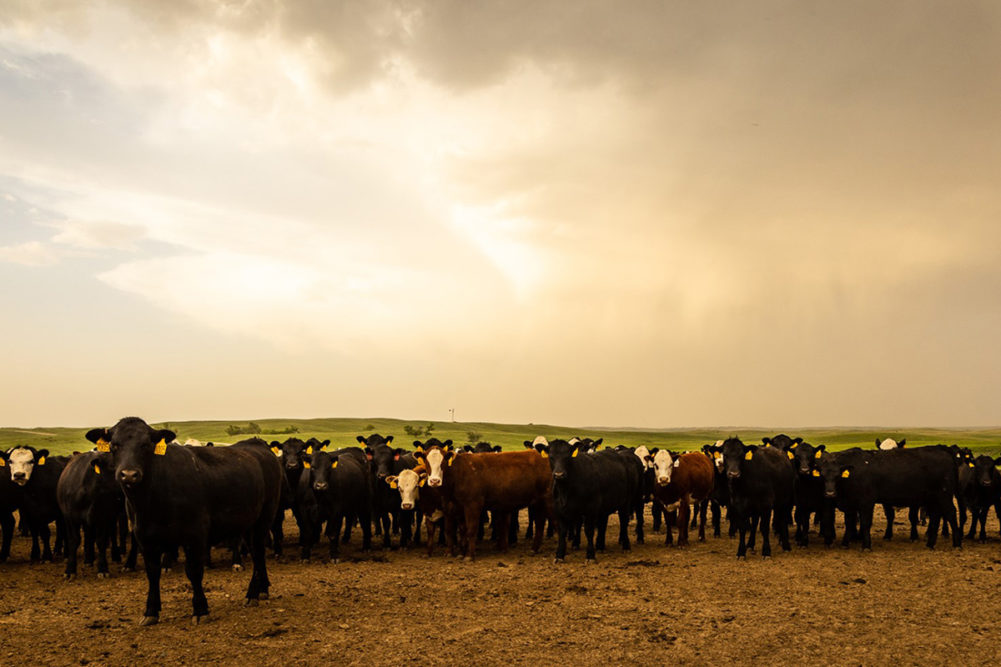Ryan Meyer, senior vice president of cattle procurement and marketing for Creekstone Farms, Arkansas City, Kan., noted the company takes its commitment to sustainability beyond the animals in its care and extends it across every aspect of the business, including ranchers, team members, consumers and the communities where employees live and work.
“We work with producers who employ sustainable practices like rotational grazing and have made improvements to our processing plant and distribution center to conserve limited natural resources,” he said. “The next focus is animal welfare — in addition to working with ranchers who are focused on humanely raising their animals, our Natural Black Angus Beef is verified by Certified Humane, a third-party auditing company that has specific animal care standards that must be met for animals to be approved for the program.”
Cargill is offering no-antibiotic and no-hormone beef in its PureRange Reserve Angus line, part of its BeefUp Sustainability Program, an initiative committed to achieving a 30% greenhouse gas intensity reduction across the company’s North American beef supply chain by 2030.
“As we see some companies backing away from programs and announcements, we think this trend of transparency is going to continue as the complexity of sustainability gets more real,” said Hans Kabat, president of Cargill’s North American protein busines. “Many of the sustainability solutions in the protein space are new innovations, which means we need to ensure they deliver the positive environmental, social and economic benefits we want to drive and accelerate — all with the ultimate goal of driving positive impact for people and the planet.”
Ray Rastelli, Jr., president of Rastelli Foods Group in Swedesboro, N.J., noted that one of the latest trends in this segment is regenerative meats.
“Regenerative beef comes from cattle raised and fed by way of regenerative grazing using regenerative agriculture,” he said. “It allows animals to gain more nutrients from chemical free soil. The benefits are it fights climate change, cuts down on pollutants like carbon dioxide and nitrogen oxide, it grows new, healthy topsoil, and rebalances ecosystems and protects beneficial insects, including pollinators like bees.”
Rising consumer interest
Consumers are not only thinking about their own health but are also concerned about the environmental impact of their choices. They want to make better, more informed decisions when shopping for protein.
Furthermore 63% of consumers want to know more about the who, what, where, and how behind the food they buy, according to proprietary Cargill research.
“Because of this, protein suppliers are carefully evaluating labels and are proactively providing more information surrounding the path to protein purchase,” Kabat said. “We’re also working even more closely with our network of farmers, ranchers, and retailer and foodservice customers to better support them on their own sustainability journeys, through efforts such as our BeefUp Sustainability and our RegenConnect programs.”
Britney Banuelos, senior fresh meats brand manager for Tyson Foods, noted the target consumer for Brazen Beef is looking for products that align with their values; specifically, they seek companies that are demonstrating commitment to protecting the environment.
“These shoppers are seeking to minimize their impact on the environment and are willing to educate themselves on topics that interest them, such as sustainability,” she said. “We are seeing strong consumer demand for these types of products.”
Packaging matters
Packaging is an important opportunity to connect with consumer values as it is a product’s initial touchpoint with consumers, so the perfect opportunity to communicate brand attributes and production claims.
“Clean label claims for beef are among the most important attributes that consumers consider when making their purchases, ranking as high as USDA grades,” Kabat said. “We’re seeing great opportunity for transparency and consumer education at the meat case, given their interest in purchasing products that align with their values and commitment to sustainable practices.”
Additionally, products with plant-based fiber packaging or packaging that is designed to be recyclable is a great way to show commitment to practices beyond the beef product itself.
“Showcasing a full brand story from pasture to production, and through packaging and merchandising, helps consumers see the value provided in a premium program,” Banuelos said.
Meyer points out that labeling is the easiest way for consumers to learn a product is sustainable.
“It’s definitely important to tell the story of your meat brand on the label,” he said. “Additionally, while on-product labels are critical to telling our sustainability story, it’s equally important that we’re telling this same narrative on our website and social channels to satisfy the customer who wants more information about our company and our products.”
The road ahead
Rastelli notes that throughout the first half of 2023, sales for sustainable meat products have held steady, but as prices continue to rise people are making different choices for more cost-effective purchases which does impact the category.
“Still, consumers believe that when a product is handled in a way that benefits them and the planet, it’s important to play a small role in helping to make a change for the greater good,” he said.
While meat is not expected to fall too far in the years ahead, sustainable consumption and production will be at the heart of its success.
“With respectful stewardship of the planet, our crops, our animals and our people, consumers will make more informed choices about what they buy and who they buy from.”
This article is an excerpt from the August 2023 issue of Supermarket Perimeter. You can read the entire Sustainably Raised feature and more in the digital edition here.

